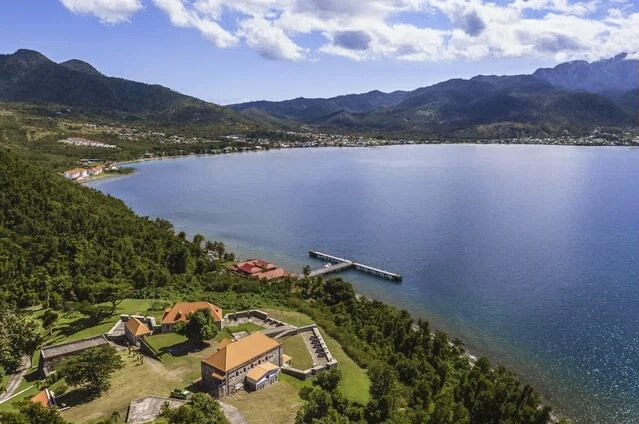North of Dominica

The North of Dominica region is rich in natural beauty, cultural heritage, and economic activity. Stretching from the vibrant town of Portsmouth to the serene villages nestled along the coast and inland valleys, this area showcases the island’s diverse landscapes and dynamic communities. Known for its lush rainforests, volcanic peaks, pristine beaches, and historical landmarks, the northern region is a treasure trove for locals and visitors seeking adventure, tranquillity, and cultural immersion.
Geography and Natural Features from the North of Dominica
The North of Dominica is defined by its rugged landscape, volcanic formations, and coastal splendour. Dominated by the imposing presence of Morne Diablotin, the island’s highest peak at 1,447 meters (4,747 feet), the region is part of the Morne Diablotin National Park. It is part of a tentative list of UNESCO World Heritage sites in Dominica. This park is home to dense rainforests, rare wildlife, and the source of several rivers, including the Pagua River and the Dublanc River, which nourish the fertile volcanic soil below.
Coastal areas such as Douglas Bay, Toucari Bay, Batalie Bay, and the striking Red Rocks offer breathtaking views of the Caribbean Sea, with opportunities for snorkelling, scuba diving, and fishing. The scenic beauty is complemented by black sand beaches, dramatic cliffs, and hidden coves, making it a haven for nature lovers and eco-tourists.
The region also includes significant segments of the Waitukubuli National Trail (WNT), the Caribbean’s longest hiking trail. Notably, Segment #12, Segment #13, and Segment #14 traverse through lush forests, historic sites, and coastal paths, offering hikers immersive experiences in Dominica’s cultural and natural landscapes. These segments highlight pristine rainforest areas, panoramic ocean views, and connections to villages steeped in cultural history.
Historical Background of the North
The history of the North of Dominica is deeply rooted in the island’s colonial past, indigenous heritage, and post-emancipation era. The region was once a stronghold for the Kalinago, the indigenous people of Dominica population, who thrived along the northeastern coast. During the colonial period, the area saw conflicts between French and British forces, particularly around Fort Shirley in Cabrits National Park, a significant military site built in the 18th century.
Post-emancipation, the northern communities developed agricultural settlements and fishing villages, with Portsmouth emerging as a key commercial hub. Historical figures from this region, such as Edward Oliver LeBlanc, Dominica’s first Premier, played pivotal roles in shaping the island’s political landscape.
Major Towns, Villages, and Key Landmarks
The economic and cultural heart of the region is Portsmouth, Dominica’s second-largest town. It is a hub for commerce, education, and tourism, with key institutions like the American Canadian School of Medicine (ACSOM) and the bustling Portsmouth Market. With its historic Fort Shirley, the nearby Cabrits National Park offers insights into the island’s colonial past and panoramic views of the surrounding seascape.
Surrounding Portsmouth are vibrant neighbourhoods and villages collectively contributing to the town’s dynamic character:
- Picard, Zicack, and Glanvillia: These interconnected neighbourhoods form part of the broader Portsmouth area, hosting educational institutions, residential communities, and local businesses.
- Toucari: Known for the peaceful Toucari Bay, traditional fishing community, vibrant marine life, and excellent snorkelling spots.
- Dublanc and Bioche: Small coastal villages with rich agricultural activities, local festivals, and strong community ties.
- Bense, Anse De Mai, and Penville: Inland communities offer stunning northern coastline views and access to hiking trails.
- Vieille Case and Thibaud: Notable for their cultural festivals, historical significance, and scenic coastal views.
- Savanne Paille: Offering panoramic views of the Caribbean Sea and mountainous terrains.
- Colihaut and Coulibistrie: Known for their rivers, vibrant community life, and scenic coastal landscapes.
- Pointe Baptiste: Famous for the striking Red Rocks and panoramic ocean views.
Notable natural landmarks include the Cold Soufrière, a rare cold volcanic spring bubbling with natural gases, and the coral reefs along the Toucari Marine Reserve, which support vibrant aquatic ecosystems. Other key features include the Indian River, the longest navigable river in Dominica, offering boat tours through lush mangroves.
Road Networks and Transportation
The North of Dominica is connected by a network of major roads that facilitate transportation and economic activity:
- Edward Oliver LeBlanc Highway: A vital coastal route linking Portsmouth to Roseau and other key southern regions.
- Northern Link Road: Connecting coastal villages, providing access to scenic views and agricultural areas.
- Melville Hall – Portsmouth Road: This leads to the western parts of the island, passing remote communities like Borne, Dos D’ane, Paix Bouche offering access and hiking trails and natural features.
These roads connect communities and support trade, tourism, and emergency response efforts.
Cultural Heritage and Traditions
The North of Dominica is a melting pot of cultural influences, deeply tied to the island’s Kalinago heritage, African ancestry, and European colonial history. Traditional festivals, such as the Feast of St. John in Penville and local Independence celebrations, showcase vibrant music, dance, and Creole cuisine.
The region is also known for its artisanal crafts, including basket weaving, wood carving, and pottery, reflecting the creativity and resilience of the local people. Churches, historical landmarks, and community centres are pivotal in preserving these cultural expressions, fostering a strong sense of identity and community pride.
Flora, Fauna, and Marine Ecosystems
The biodiversity of the North of Dominica is exceptional, with ecosystems ranging from mangrove swamps to montane forests. The region is home to endemic species such as the Sisserou Parrot (Amazona imperialis), the national bird of Dominica, in the Morne Diablotin National Park. Other wildlife includes the Jaco parrot, Agouti, and various species of frogs and lizards.
Marine life is equally diverse, with coral reefs, endangered sea turtles, dolphins, and whales frequenting the coastal waters. Protected marine areas, such as the Cabrits National Park Marine Section, the Toucari Marine Reserve, and the vibrant reefs near Douglas Bay, play a crucial role in conserving these ecosystems.
Tourism, Hospitality, and Local Cuisine
The North offers a diverse range of accommodations, from luxury resorts to eco-lodges:
- Secret Bay: A world-renowned luxury resort offering private villas with stunning ocean views.
- The Champs Hotel: Known for its panoramic views over Portsmouth and warm hospitality.
- InterContinental Dominica Cabrits Resort & Spa: A premier resort offering world-class amenities and beach access.
- Toucari Cottages: Eco-friendly lodges nestled along the scenic Toucari Bay.
Local cuisine is a vibrant reflection of Dominica’s cultural diversity. Visitors can savour Creole dishes such as callaloo soup, fried plantains, grilled fish, crayfish and root crops at local eateries and beachside restaurants.
A Region of Promise and Potential
The North of Dominica region has remarkable beauty, rich heritage, and dynamic potential. Its diverse landscapes, vibrant communities, and commitment to sustainability make it a vital part of Dominica’s identity and future. Whether exploring its rugged trails, engaging with its cultural traditions, or contributing to its economic growth, the North offers endless possibilities for discovery, connection, and inspiration.




